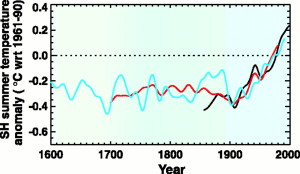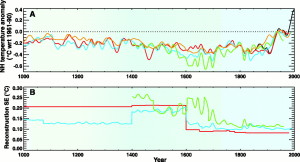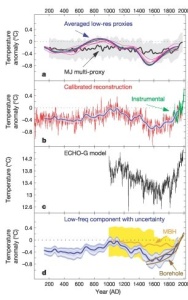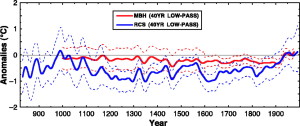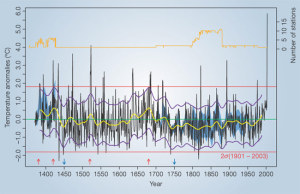I’ve been on the case of Michael Mann for some time now, and something I suspected would happen has happened. I’m finding myself in slightly the wrong company here. There is a certain number of people who are saying that a majority, or even all climate scientists are faking data, or are part of some conspiracy, or the rest of it. I’m sorry to say that Mark Steyn seems to be steering close to this; I don’t want have a go at a man who says stuff is ‘remarkably prescient’ so I’ll just focus on this argument.
I will have no truck with that line.
I will not have good scientists accused of the worst sin without rock solid evidence on every one of them. I’m certainly not going to go along with any blanket accusation of climate scientists in general from people who probably couldn’t name a single one, apart from Mann.
However…
I know I’m in a fortunate position here. I can access the science directly. I have often wondered, if I wasn’t able to do that, and didn’t have my own background in the sciences, would I think climate change is real? If I had to watch the politicised, simplified hackwork that is paraded in the press – would I have the same level of confidence?
How Science really works
Simply put, most people who write on this subject don’t really understand how science works. That’s the only way the idea of some sort of a conspiracy among scientists can make sense. Simply, if you tried to hold some sort of a meeting to organize ‘the line’ on global warming, what would happen would be PhD students and other showing up to scarf all the free food before returning to do… exactly what they were planning to do in the first place.
As a group, scientists are hard to organise into going to the same lab meeting. A global conspiracy or collusion among scientists? Ludicrous.
Ah, but you say, what about all those research funds… Well, here’s a reality check: we don’t shovel all those research funds into our own swiss bank accounts. We want the research funds to do research. To find the truth. There’s not much point otherwise.
That engenders a certain deep trust amongst scientists that is hard to understand if you’re not one. Whenever I read a scientific paper my very strong prior is that the author is honest and scrupulous, and knows more about whatever it is than I do. Anyone who has ever done a PhD knows the strange feeling that you know for a fact more about a tiny little area of knowledge than anyone alive now or who has been alive in history. It’s quite something. I’ve occasionally (okay, once) found myself correcting a Nobel laureate (real one) on a point in a presentation and realizing that I was the only one who knew that point. It was… invigorating.
Now, with everyone operating on this high level of trust, of course, comes the occasional problem. This is one of my all time favourite paper titles:
I won’t bore you with the details, but basically what the paper shows is that people were barking up the wrong tree for four decades because they didn’t notice that the original experiment didn’t have enough salt in it.
This sort of thing does indeed happen. But in case you’re holding your breath that something like this will come to light about global warming, and that this will disprove it, please don’t. No completely gross error could be sustained throughout the decades.
The above mistake really was genuine, and people were indeed on the wrong track but, and this is the glory of science, while chasing down the wrong track they made all sorts of other discoveries – great discoveries, magnificent discoveries that shed a great deal of light on that subject. So when the original error was corrected, everything pretty much fell into place.
The fall of Mann
You may get some idea of where Mann fits into this picture of climate science. If the trust network among researchers is so strong that they may be lead astray by a simple misreading, how much more so can they be lead astray by active distortion?
If Mann had just been willing to publish his original hockey stick, and keep working and not mind when it was overhauled and superseded by far better work – none of us would be having this discussion. That would have been perfectly fine. Things are so different because Mann, I am sorry to say, seem to have embraced the political over the scientific.
The way I see things happening, from the witnesses of his conduct down the years, is that a young PhD candidate found a chance to be part of the IPCC, to have an express ticket right to the top. So he pushed a little harder for his ideas than was strictly warranted. Remember, later the National Academy of Sciences would conclude about the hockey stick:
“The IPCC used it as a visual prominently in the report […] I think that sent a very misleading message about how resolved this part of the scientific research was. “
Then later on he found himself attached to it, and pushed a little harder.
Regarding the Hockey Stick of IPCC 2001 evidence now indicates, in my view, that an IPCC Lead Author [Michael Mann] working with a small cohort of scientists, misrepresented the temperature record of the past 1000 years by (a) promoting his own result as the best estimate, (b) neglecting studies that contradicted his, and (c) amputating another’s result so as to eliminate conflicting data and limit any serious attempt to expose the real uncertainties of these data.
And the next thing you know he was in the business of intimidating other researchers, Climate Science Made Flesh and all the rest of it. He was the public face of climate science and he enjoyed it.
So, you may ask, why did no one call him on it? Well, with the juniors there was probably a tendency to toe the line, but there is another thing: for most of us, politics is the last thing we want to get involved in. Frankly, my ideal world would be one in which I could be left alone to do science and never have to even think about politics, or religion, or anything else for that matter. I would suspect that the majority of climate scientists felt about Mann’s activities that, basically, it’s a mucky job but someone’s got to do it and Mann seems to like it.
There’s another thing here, and this is where the political right, especially the American right, needs to take some responsibility. This is its persistent flirtation with absurd nonsense like creationism and whatnot. By playing around with this stuff, they’ve made themselves incredible ab initio. I suspect that most climate scientists – who, again, don’t really care that much for politics – just reflexively circled the wagons at some of the diatribes about climate change, without understanding the deep arguments that have happened behind it.
So when Steyn writes that “For a year or two around the turn of the century, he over-egged the pudding very usefully for them”, it’d be good to know which ‘them’ he means. If he means the apparatus climate media & ngo racket, then he’s probably right. If he means the real scientists, then he’s wrong, as you will see shortly.
(N.B. I imagine a three year lawsuit and all its costs does leave one remarkably short on sympathy)
And there are indeed genuine people of questionable integrity out there, on the anti-AGW side. Please watch the following interview with Ian Plimer and try to say that he doesn’t look as shifty as Mann in’t:
http://www.youtube.com/watch?v=iEsygjXunTs
Please note: that when pressure was brought, and the hockey stick was re-examined the previously quoted National Academy of Sciences did indeed find that the thing was faulty. Scientific integrity prevails.
I’m going to take a look at what some of the science tells us in a lovely Mann-free world. You may be surprised what we find. If you are surprised, please remember: there is a significant difference between what you read in the literature and what is seen in the press. For example, in Al Gore’s film he claims that the oceans will rise twenty feet by the end of the century. The problem is that the IPCC Says that they will rise two feet. Please keep that difference in mind whenever you see some apocalyptic headline.
Carbon Dioxide is on the up and up, and it’s mostly man-made
You can in fact drill down through various ice cores and find bubbles of air trapped there, and learn just how much carbon there used to be. I’m sorry to say that this is primarily dominated by human emissions. I can’t find the original article, but there is one where Mark Steyn claims that 95% of carbon emissions are natural. I’m sorry, but that’s poppycock. Natural carbon emissions are largely locked into the carbon cycle. What we are releasing is material from fossil fuels – carbon reserves built up over hundreds of millions of years and being released in far shorter timescale.
Basically, humans are releasing 26 billion tons of carbon into the atmosphere a year. That’s not disputed. We know that carbon dioxide traps heat. That’s not disputed either. So it’s just nuts to assume that we can change things on this scale with no consequence.
Ah, but what are those consequences? That’s where things get interesting.
What does the climate of the past look like?
Here’s a lovely paper that looks at the relationship between CO2 and the great changes of ice ages and their end. As they say,
During the Middle Miocene, when temperatures were ~3° to 6°C warmer and sea level was 25 to 40 meters higher than at present, pCO2 appears to have been similar to modern levels.
Well, open and closed, right? We’re about to see 25 to 40 meters of sea level rise?
Er, not exactly. Look at the timescales involved. The paper is discussing twenty million years of history. So, yes, it could well be that within another repeat of that time scale we’ll see major changes. For the record, that doesn’t necessarily mean that what we do today will not have repercussions for a long time. I’ve spoken with scientists who’ve said that, even if we stopped all carbon emissions today, we’d be seeing warming going on until at least the year 2150.
But what can we find out in a bit closer range? This is where things get really problematic.
Since we don’t have records of temperature going back more than a hundred years or so, we have to rely on proxies – things that are dependably affected by temperature that we can look at. Tree rings are the classic, but there’s also pollen, grapes….
We can start with this paper, as you can see, published in Science. What we get from it, is the following graph, which looks like the Mann’s hockey stick:
The paper says, quote,
The 20th century experienced the strongest warming trend of the millennium (about 0.6°C per century).
Again, pretty strong huh? But it goes on to say:
Some recent changes in ENSO may have been unique since 1800, whereas the recent trend to more positive NAO values may have occurred several times since 1500. Uncertainties will only be reduced through more extensive spatial sampling of diverse proxy climatic records.
This is a persistent problem throughout the climate record. Trying to reconstruct the climate of the planet via a handful of proxies is always going to be difficult.
Incidentally, take a look at what you get if you extend the graph backwards:
Please notice again the black line, which is the measurement readings, that goes above and beyond the point where the proxies stop. I have never understood doing this in so many papers – why can’t we just track the proxies along with the temperature readings? That’d surely be a much better way of doing things?
Again, it’s not anywhere near as dramatic as Mann’s graph, but the warming is definitely there.
But is this really an accurate picture of how this goes down? More to the point, is this an absolutely accurate picture of what happens? Not everyone agrees. Here’s another lovely graph from Anders Moberg:
What you see here is rather different. You see a temperature peak at about 1000 -1,2000 years ago (depending on what you look at) and that temperatures then were a shade below what they are now. Then we had a long, deep cooling phase, and this was following by the modern warming.
Now compare this graph to the old Mann graph:
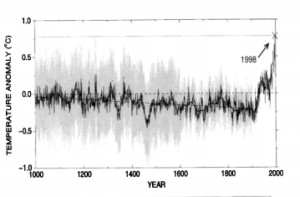
The Mann graph shows what is basically a flatline until the nineteenth century. The Moberg graph shows a gradual decline until about 1600 when things start to pick up again. Those two graphs tell us very different things: the Mann graph says that the warming is predominantly or exclusively manmade (as it were), the Moberg graph says that there’s a natural warming cycle in addition to the human caused global warming.
As Moberg puts it:
This large natural variability in the past suggests an important role of natural multicentennial variability that is likely to continue.
(This was published in Nature, so please spare me the #Kochfundeddenialist stuff)
From our point of view – that’s actually worse news, because it places a severe limit on what we’re able to accomplish, even if we manage to reduce carbon emissions.
So which picture is accurate? As I’ve indicated, I don’t trust Mann. I’m hardly alone – here’s another Science paper by Jan Esper. It is specifically reconstructing the temperature in the Northern Hemisphere. Take a look at this:
The red line is ‘MBH’ – Mann-Bradley-Hughs. Notice that it shows basically no variability over the last thousand years, but the RCS chronology shows a far more variable climate. The paper concludes that, well, the RCS only looks at the Northern Hemisphere, and Mann looks at the whole planet, so that’s why things were flat overall, and there’s a big computer model that back him up. I frankly don’t buy this. Firstly because, though I’m not a climate scientist, I do know computer models, and they are to be treated extremely carefully unless they have a lot of proof backing them up. Secondly, and more importantly, the Mann hockey stick is principally a Northern Hemisphere thing. To quote him directly, in response to the National Academy of Sciences investigation:
Mann says that he is “very happy” with the committee’s findings, and agrees with the core assertion that more must be done to reduce uncertainties in earlier periods. “We have very little long-term information on the Southern Hemisphere and large parts of the ocean,
And, yes, that red line is the original hockey stick – look at the references in the Esper paper.
My general impression from these papers is that part of the reason that the warming looks so drastic is that we’re pulling out of a particularly cold time. Take the following paper by Shaun A. Marcott, which points out that about 200 years ago we were in the coldest we’d been for five thousand years.
I can keep doing this, or you can just look at the Pages2K consortium and see that things change quite a bit depending on which continent you are interrogating. Or, for that matter, what proxy you use. Here’s a proxy reconstruction that relies on grape harvests and ripening times:
Published in Nature. The
This business that the picture changes depending on the measuring technique you use is quite well know. Take this paper from Geophysics Research Letters.
By combining 6 standard criteria to define variants of the basic regression method used in MBH98 we have found an enormous spread in the resulting millennial NHT reconstructions from AD 1400 onwards, with none of the criteria being solely accountable for the spread. This uncertainty persists even among the best performing variants, and we believe that we were able to trace it back to a scale mismatch between the full millennial and the calibrating proxy variations. Under such circumstances, the regression model leaves its generic domain of validity and is applied in an extrapolative manner. Even if linearity still holds for the larger scales, the error is prone to be linearly inflated by those scales.
Any robust, regression-based method of deriving past climatic variations from proxies is therefore inherently trapped by variations seen at the training stage, that is, in the instrumental period. The more one leaves that scale and the farther the estimated regression laws are extrapolated the less robust the method is. The described error growth is particularly critical for parameter-intensive, multi-proxy climate field reconstructions of the MBH98 type. Here, for example, colinearity and overfitting induce considerable error already in the estimation phase. To salvage such methods, two things are required: First, a sound mathematical derivation of the model error and, second, perhaps more sophisticated regularization schemes that can keep this error small. This might help to select the best among the 64, and certainly many more possible variants. In view of the relatively short verifiable period not much room is left.
Short summary is as follows: if you try to apply the Mann method, you can get all sorts of pictures of the past depending on how you run it. And the further back you go, the less likely that it holds together.
As regards the general business of proxies, here is Hans von Storch in Science:
The centennial variability of the NH temperature is underestimated by the regression-based methods applied here, suggesting that past variations may have been at least a factor of 2 larger than indicated by empirical reconstructions.
And from the text:
Athough the amplitude of these preindustrial variations is still debated, according to the most quoted NH temperature reconstruction [Mann, Bradley, Hughes, 1998 (MBH98) (1) and Mann, Bradley, Hughes, 1999 (MBH99) (2)] and the most recent Intergovernmental Panel on Climate Change (IPCC) report (7), these variations were of small amplitude. However, recent studies with general circulation models suggest that these centennial variations may have been larger
The real argument, as has been said, about the hockey stick isn’t the blade but the stick – the long flatness doing nothing for a millenium. What the von Storch paper is saying clearly is that this is nonsense, because it underestimates the noisiness of the signal.
In summary then:
1. Our planet is warming.
2. Anyone who says human influence has nothing to do with it is wrong
3. Anyone who says that natural influences have nothing to do with it is also wrong.
Now, dear reader, can I ask you this: Has anyone ever laid out the issues like this for you? I don’t follow the popular media on climate science, but has anyone ever written or said something like “Scientists are debating how clear our knowledge of the climate of the last thousand years is”? Or “Scientists are concerned that earlier techniques may have underestimated the amount of climate variability over the last thousand years”? Or even “We are living as part of a general global warming trend, but it varies from continent to continent, and we’re trying to determine how much of it is natural and how much is man made “?
I have a distinct feeling that the answer to this is ‘no’.
You see then how the dialogue of the deaf works. Credible climate scientists hear all the accusations made, but they are looking at the primary work and they know how carefully it is done, so they think to themselves “Well, this lot must be a bunch of cranks”. Meanwhile, the public is looking at the grossly distorted and sensational picture presented in the media and goes “Well, if they believe this, they must be frauds”.
So much for the whole ‘Koch funded denialist machine’.
And so much, also, for the idea of some scientific cabal. Read back over those papers and look at the dates. Reputable scientists have been disassembling the hockey stick for a long while now. The reason that none seem to want to support Michael Mann is, I suspect, that they are just now realizing (as I have pointed out repeatedly) that he presents a different face to the world than the one he presents to the scientific community, or rather, a different stick.
So, what does this mean for the future?
Here’s where things get interesting, and also horribly difficult. How solid our grasp on the past is proportional to how well we can predict the future. As we’ve seen, the knowledge of the past is less than you might expect. Hence the failure of current climate models to predict the current warming pause.
(Remember Mann’s comment that we have very little data on ‘parts of the ocean’? )
The future is certainly uncertain, at least to a degree. The trouble here is that ‘uncertain’ implies that things could go better than we think, they could also much worse than we think. So here we enter fraught territory.
Here, I cleave to the IPCC line on predictions, or more accurately, the ‘best guess’ on what will happen. What you see if you read it is that there’s a problem. What there is emphatically not is The End Of Days.
Take, for instance, the issue of sea level rise. As I mentioned before, there is a lot of hype on this – increased flooding and whatnot. Al Gore, I repeat, makes much of the apocalyptic vision of first Greenland and then the Antarctic melting. That would indeed be a disaster like you cannot imagine.
The trouble with the Gore vision is that it isn’t backed up by the science. The IPCC places the sea level rise between 0.33-0.66 cm (one to two feet), and the most extreme models I’ve seen published in Science place it at two meters over the course of the next century. Now, that’s a lot, to be fair, but it’s a) not at apocalyptic levels, and b) at the end of the century.
So here I need to make another adjustment:
Any projection of doing things now to change things in the year 2100 is a complete waste of time.
Why? Because it cannot factor human ingenuity and human action. imagine someone in the year 1914 trying to project the life of his great grandchildren in 2000. Now add to the fact that technological progress is exponential, not linear.
For this reason, I’m focusing on what they call the ‘near term’ climate change scenarios, the ones up to 2050. Also, to be frank, the projections beyond the year 2050 are something of a dart board, with projections ranging from 0 degrees to 4.5 degrees increase. Bearing in mind the troubles that models have, I’ve also restricted myself to the IPCC’s high confidence and very likely projections, given the troubles that the models tend to show (as documented previously).
To summarize and simplify, we’ll see an increase in precipitation in the northern hemisphere, an increase in heat deaths with a larger decrease in cold deaths, and there will be an increase in flooding. Tropical storms will change their distribution, though the IPCC seems to be unsure what form that will take – if someone is attributing hurricanes to global warming, they are simply not correct. Disordered stuff about a new ice age in Europe (The Day After Tomorrow) is nonsense. Upticks in temperature probably will see diseases like malaria spread further. Agriculture is a bit of a difficult one to work out – there could be either a modest decrease or a modest increase in agricultural production. Water stress will increase in some areas of the developing world, but will decrease in others.
The IPCC is a weighty document, but I do encourage people to go and take a look at it for themselves. I’d also recommend Bjorn Lomborg’s excellent film and bookd Cool It
https://www.youtube.com/watch?v=eZR3gsY98VU
And before anyone starts up about Lomborg being ‘disproven’, please read the following. I have carefully checked Lomborg’s footnotes and I have found that the bulk of the accusations against him are simply false.
So what do we do?
Here is the point I completely break with the consensus. First of all, whenever you hear something like ‘Climate scientists say we should do such-and-such’, you’re being had.
Why? When was the last time you asked a plumber to look at your electrical wiring? Or a computer scientist to do genetic engineering?
Policy solutions and engineering solutions to climate change are outside the area of expertise of climate scientists. They are restricted to saying “If we have such-and-such an amount of CO2, then this will happen”. In terms of appeals to authority, they have no better claim than anyone else.
If you want to talk about how to measure the costs of global warming and the various cost-effective solutions of it, as compared with other costs, then that belongs in the domain of the economists (see Lomborg, above). Other specialists are needed for matters like carbon capture and the rest.
I’ve written before why I think that big government solutions to global warming are nonsense. Command and control, carbon cuts are just not going to happen. Apart from anything else, it is deeply immoral to try to impose these on the developing world – and also is never going to work when it comes to imposing these means on China or India.
The one thing that can solve this mess is research. I’ve long been a proponent of a manhatten-style project to get us all off oil. Apart from anything else, ISIS is getting something like three million dollars a day from Iraqi oil. It’s not just a matter of climate policy, it’s a matter of civilizational security to fix this. Further, there happens to be a cheap, clean source of energy with no carbon emissions: it is called nuclear power. The more sensible and intelligent environmentalists have come out in favour of this energy source, and it would be an important move in the right direction. Solar energy is currently too expensive, but further research and improvement is always possible.
There is also the business of carbon capture. Simply, once carbon is up, it’s up, and you cannot get it back down easily. Ideally, we should be looking to find a way to capture carbon en masse, and bury it so that it can’t cause any further troubles. I know that Richard Branson has been sponsoring research into exactly this.
These outline some fruitful areas of research, and I maintain that a lot of that could be funded by private initiative. We might actually get things done that way.
In the meantime, there’s a lot of prosaic work of adaptation that can be done. People don’t talk about this, but it is the main, and effective thing that we can do now. Remember, a significant chunk of warming is coming no matter what is done, so adaptation is a necessity.
For example, increased range of malaria is a worry. But malaria is a problem right now in any case, so dedicating some time to eradicating it (draining swamps, exterminating mosquitoes, distributing bednets etc.) is money well spent. Meanwhile, rising sea levels and flooding dangers can be compensated for by flood barriers – and we’ve seen in the case of New Orleans what happens when these are ill maintained (again, a point about big government failures, but I digress).
Addendum: The Environmentalist agenda
There’s something I should have touched on something, which is the perversion of science. That’s much worse than anti-science. We in the skeptisphere make fun of creationists, and they usually deserve it, but consider:
Which evolutionary pseudoscience caused more damage during history:
a) Creationism
or
b) Eugenics?
Creationism is obviously wrong, but Eugenics is less obviously so. That is why it was so dangerous. Eugenicists spoke and argued in the language of evolution, and did indeed champion reforms such as cleaning up the homes of the working class to prevent disease and mutation, improve diet and healthcare – and also laid the intellectual basis for some of the worst crimes in human history?
I’ve written about this before. Right-wing anti-science is annoying – left-wing antiscience is positively lethal. Nor can we pretend that this sort of stuff is consigned to the dark days of Eugenics and Lysenkoism:
James Lovelock has said it might be necessary to “put democracy on hold for a while”.
Mayer Hillman, senior fellow at the Policy Studies Institute in London agrees with him.
James Hansen, head of NASA’s Goddard institute, “Chinese Leadership needed to save humanity”.
David Suzuki, Canada’s famous environmentalist: ““What I would challenge you to do is to put a lot of effort into trying to see whether there’s a legal way of throwing our so-called leaders into jail because what they’re doing is a criminal act,”
The New York Times‘ Thomas Friedman. “One party autocracy certainly has its drawbacks. But when it is led by a reasonably enlightened group of people, as China is today it can also have great advantages”.
History seems to be repeating itself. You get a number of people who can kinda, sorta talk sciencey who are perverting good science in the name of a monstrous ideology. In the same way that you don’t have to be a molecular biologist to smell danger when someone says “MAO-A distribution proves that blacks will always be more criminal and violent”, you don’t have to be a climate scientist to smell danger when people start talking like that.
This agenda has already done some awful things. When you’ve seen Greenpeace & Children of the Earth bragging about how the block GM food to the worlds’ poorest, or prevent the building of hydroelectric dams and power stations, or John Kerry telling Africans that they shouldn’t build more farms because it releases CO2 – then you start to see this agenda in play. And I’m not surprised that people don’t like it very much.


